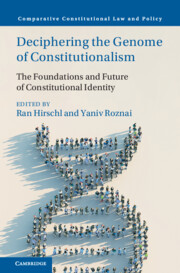Book contents
- Deciphering the Genome of Constitutionalism
- Comparative Constitutional Law and Policy
- Deciphering the Genome of Constitutionalism
- Copyright page
- Contents
- Figures
- Contributors
- Preface
- Acknowledgments
- Introduction
- Part I Foundations, Theory, and Concepts
- Part II Comparative Perspectives
- Part III American Constitutionalism and Constitutional Identity
- Part IV Emerging Trends
- 19 Constitution Making and Disharmonic Identity
- 20 Constitutional Identity and Unamendability
- 21 Illiberal Constitutionalism and the Abuse of Constitutional Identity
- 22 Deconstructing Constitutional Identity in Light of the Turn to Populism
- 23 Unconstitutional Constitutional Identities in The European Union
- 24 What Counts as Constitutional Identity?
- 25 Contrariness and Contradiction in Constitutional Law
- 26 Conclusion
- Index
- References
19 - Constitution Making and Disharmonic Identity
from Part IV - Emerging Trends
Published online by Cambridge University Press: 14 March 2024
- Deciphering the Genome of Constitutionalism
- Comparative Constitutional Law and Policy
- Deciphering the Genome of Constitutionalism
- Copyright page
- Contents
- Figures
- Contributors
- Preface
- Acknowledgments
- Introduction
- Part I Foundations, Theory, and Concepts
- Part II Comparative Perspectives
- Part III American Constitutionalism and Constitutional Identity
- Part IV Emerging Trends
- 19 Constitution Making and Disharmonic Identity
- 20 Constitutional Identity and Unamendability
- 21 Illiberal Constitutionalism and the Abuse of Constitutional Identity
- 22 Deconstructing Constitutional Identity in Light of the Turn to Populism
- 23 Unconstitutional Constitutional Identities in The European Union
- 24 What Counts as Constitutional Identity?
- 25 Contrariness and Contradiction in Constitutional Law
- 26 Conclusion
- Index
- References
Summary
This chapter explores the ways that the concept of a “disharmonic constitution” provides a useful analytic lens for the comparative study of constitution making in religiously divided societies. We consider constitutional design strategies that enable and allow for disharmonies – including choices to include ambiguity and even contradiction within a constitutional text, as well as to defer certain questions for incremental resolution through ordinary politics rather than textual entrenchment. These strategies demonstrate the utility and even centrality of dissonances in interpreting the “unfinished symphony” that is constitutional identity. In the chapter, we explore these themes by considering constitutional design in the Turkish and Israeli cases. We highlight the ways in which the concept of “disharmonic constitutionalism” and the significance of dissonance in constitutional design point towards a toolkit of options for religiously divided societies that seek to draft constitutions that manage rather than resolve underlying tensions over questions of constitutional identity. We share with Jacobsohn an appreciation for constitutionalism as an expression of contingent and local identities, negotiated across historical processes of contestation and meaning-making with more of an evolutionary than a revolutionary character, even in countries that may undergo moments of sharp political rupture, reversal or transformation.
Keywords
- Type
- Chapter
- Information
- Deciphering the Genome of ConstitutionalismThe Foundations and Future of Constitutional Identity, pp. 245 - 258Publisher: Cambridge University PressPrint publication year: 2024

